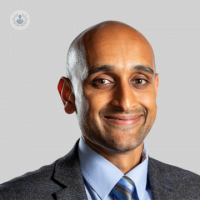Feeling hip with hip replacement surgery
Written in association with:The hips are a load-bearing support structure on the body that we use constantly for walking and sitting – when this is impaired, the range for movement is greatly reduced. We sat down with leading orthopaedic surgeon Mr Akash Patel who told us all about how hip replacement surgery can restore flexibility and ability in the hips.

The hips are the junction where the femur (the thigh bone) meets the pelvis in what is called a ball-and-socket joint. The head of the femur, called the femoral head, fits into a niche of the pelvis called the acetabulum. This is a synovial joint, meaning that the cartilage at the end of the bones is covered in a membrane that is filled with a lubricative fluid that facilitates movement and protects the bones from rubbing together, enabling the hips to move smoothly. Reasons for getting a hip replacement would be because the cartilage and membrane have worn away (osteoarthritis), become inflamed (rheumatoid arthritis), or are severely damaged in injury. Patients are left in a great deal of pain with reduced mobility, unable to walk even with a cane or walker.
What happens during hip replacement surgery?
A full hip replacement surgery involves removing the femoral head from the femur, which is then hollowed out slightly to prepare it for an implanted replacement femoral head which will be made of plastic, metal, and ceramic. A custom socket for the replacement femoral head is fitted in the acetabulum and secured with special medical cement. Finally, the replacement ball then goes into the socket.
There are variations of hip replacement surgeries, such as:
- Hip resurfacing, where the femoral head is not removed but reshaped and capped with a metal cap. This makes it easier to revise in the future.
- Partial hip replacement, where the femoral head is removed and replaced as in the full replacement, but the acetabulum is not fitted with a new socket as it is still in a workable condition.
- Simultaneous bilateral hip replacement, where both hips are needing replacement so they are operated on in the same procedure.
Before the surgery, the surgeon will assess the patient’s hip’s range of motion. The procedure is performed with a regional or general anaesthetic and takes around two hours. Most hip replacements are outpatient procedures and patients can try walking around within hours after, though they’re not recommended to drive themselves home right away, so patients may need to stay a night if there are no alternatives to get them home. A hip replacement should last at least 15 years, during which time the patient can enjoy restored flexibility and mobility, and no more discomfort or stiffness.
What happens after hip replacement surgery?
There are possible risks that come from a hip replacement, such as blood clots in the leg called deep vein thrombosis (DVT), infections, complications with the prosthesis like dislocation, muscle and ligament damage, and lingering stiffness in the joint.
Moderate pain and swelling are normal after a surgery, and patients may require painkillers for the first few days. The healing process will be over several months. Patients will need to undergo physical therapy immediately after in order to adjust to the replacement and strengthen the muscles around the joint so that capabilities can steadily increase. Exercises will include long walks, bending over, stretches, and going up and down stairs. Patients who work in offices or seated can return to work within a few weeks, but jobs that require heavy lifting or walking will need more time away, about six weeks. It will take about six to 12 weeks for patients to be able to use the hip without reservations, and they’ll be able to run, swim, dance, and climb again.
If you have been struggling with arthritis and are considering a hip replacement, book an appointment with Mr Patel via his Top Doctors profile.


